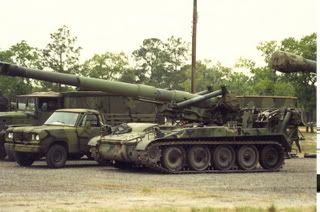Let me start by saying I dont own and have never operated a Howitzer/Mortar/Field Gun; its just something that has always piqued my interest. Im not looking for any classified/sensitive information and dont plan to put any of this to use.
Im mainly wondering, from an outsiders point of view it seems as if 155mm and 105mm Howitzers work very much like a rifle. It would seem like they are aimed much like a very long range rifle.
1) My question is, what all factors do you take into account when aiming a Howitzer?
2)Is there a ballistic coefficient/drag coefficient that you take into account with the projectile?
3)Do you ever try to measure/take into account wind speed/direction?
4)Do the same principles apply for Howitzers as for rifles, in that heavier bullets usually always give you better SD/BC and generally get you better accuracy at long range? Or do lighter projos give you better long range accuracy on account of higher muzzle velocity and lower flight time?
5)What measurement do you use when making adjustments; MOA, Milliradian, Degrees?
6)And lastly, say at a distance of 15 miles, what kind of accuracy could you expect with a 155?
Sorry for the long post and thanks for any answers.
Im mainly wondering, from an outsiders point of view it seems as if 155mm and 105mm Howitzers work very much like a rifle. It would seem like they are aimed much like a very long range rifle.
1) My question is, what all factors do you take into account when aiming a Howitzer?
2)Is there a ballistic coefficient/drag coefficient that you take into account with the projectile?
3)Do you ever try to measure/take into account wind speed/direction?
4)Do the same principles apply for Howitzers as for rifles, in that heavier bullets usually always give you better SD/BC and generally get you better accuracy at long range? Or do lighter projos give you better long range accuracy on account of higher muzzle velocity and lower flight time?
5)What measurement do you use when making adjustments; MOA, Milliradian, Degrees?
6)And lastly, say at a distance of 15 miles, what kind of accuracy could you expect with a 155?
Sorry for the long post and thanks for any answers.


